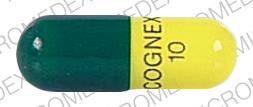Cognex Dosage
Generic name: tacrine hydrochloride
Dosage form: capsules
Drug class: Cholinesterase inhibitors
Medically reviewed by Drugs.com. Last updated on Nov 28, 2023.
The recommendations for dose titration are based on experience from clinical trials. The rate of dose escalation may be slowed if a patient is intolerant to the titration schedule recommended below. It is not advisable, however, to accelerate the dose incrementation plan.
Following initiation of therapy, or any dosage increase, patients should be observed carefully for adverse effects. Cognex® should be taken between meals whenever possible; however, if minor GI upset occurs, Cognex®may be taken with meals to improve tolerability. Taking Cognex® with meals can be expected to reduce plasma levels approximately 30% to 40%.
Initiation of Treatment
The initial dose of Cognex® brand of tacrine hydrochloride is 40 mg/day (10 mg QID). This dose should be maintained for a minimum of 4 weeks with every other week monitoring of transaminase levels beginning 4 weeks after initiation of treatment. It is important that the dose not be increased during this period because of the potential for delayed onset of transaminase elevations.
Dose Titration
Following 4 weeks of treatment at 40 mg/day (10 mg QID), the dose of Cognex® should then be increased to 80 mg/day (20 mg QID), providing there are no significant transaminase elevations and the patient is tolerating treatment. Patients should be titrated to higher doses (120 and 160 mg/day, in divided doses on a QID schedule) at 4- week intervals on the basis of tolerance.
Dose Adjustment
Serum ALT/SGPT should be monitored every other week from at least week 4 to week 16 following initiation of treatment, after which monitoring may be decreased to every 3 months. For patients who develop ALT/SGPT elevations greater than two times the upper limit of normal, the dose and monitoring regimen should be modified as described in Table 4.
A full monitoring and dose titration sequence must be repeated in the event that a patient suspends treatment with tacrine for more than 4 weeks.
Table 4. Recommended Dose and Monitoring Regimen
Modification in Response to ALT/SGPT Elevations
| ALT/SGPT Level |
Treatment and Monitoring Regimen |
| 2 X ULN |
Continue treatment according to recommended titration and monitoring schedule. |
| > 2 to3 X ULN |
Continue treatment according to recommended titration. Monitor ALT/SGPT levels weekly until levels return to normal limits. |
| > 3 to5 X ULN |
Reduce the daily dose of Cognex® by 40 mg/day. Monitor ALT/SGPT levels weekly. Resume dose titration and every other week monitoring when the levels of the ALT/SGPT return to normal limits. |
| > 5 X ULN |
Stop Cognex® treatment. Monitor the patient closely for signs and symptoms associated with hepatitis and follow ALT/SGPT levels until within normal limits. See Rechallenge section below. |
| |
Experience is limited in patients with ALT/SGPT >10 X ULN. The risk of rechallenge must be considered against demonstrated clinical benefit. |
| |
Patients with clinical jaundice confirmed by a significant elevation in total bilirubin (> 3 mg/dL) and/or those exhibiting clinical signs and/or symptoms of hypersensitivity (e.g. rash or fever) in association with ALT/SGPT elevations should immediately and permanently discontinue Cognex® and not be rechallenged. |
Rechallenge
Patients who are required to discontinue Cognex® treatment because of ALT/SGPT elevations may be rechallenged once ALT/SGPT levels return to normal limits.
Rechallenge of patients exposed to ALT/SGPT elevations less than 10 X ULN has not resulted in serious liver injury. However, because experience in the rechallenge of patients who had elevations greater than 10 X ULN is limited, the risks associated with the rechallenge of these patients are not well characterized. Careful, frequent (weekly) monitoring of serum ALT/SGPT should be undertaken when rechallenging such patients.
If rechallenged, patients should be given an initial dose of 40 mg/day (10 mg QID) and ALT/SGPT levels monitored weekly. If, after 6 weeks on 40 mg/day, the patient is tolerating the dosage with no unacceptable elevations in ALT/SGPT, the recommended dose-titration may be resumed. Weekly monitoring of the ALT/SGPT levels should continue for a total of 16 weeks after which monitoring may be decreased to monthly for 2 months and every 3 months thereafter.
More about Cognex (tacrine)
- Check interactions
- Compare alternatives
- Drug images
- Side effects
- During pregnancy
- Drug class: cholinesterase inhibitors
Professional resources
Related treatment guides
Further information
Always consult your healthcare provider to ensure the information displayed on this page applies to your personal circumstances.


